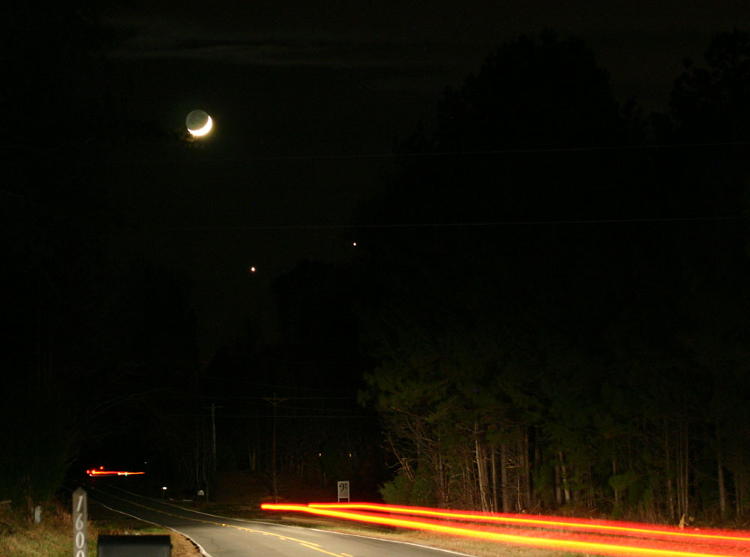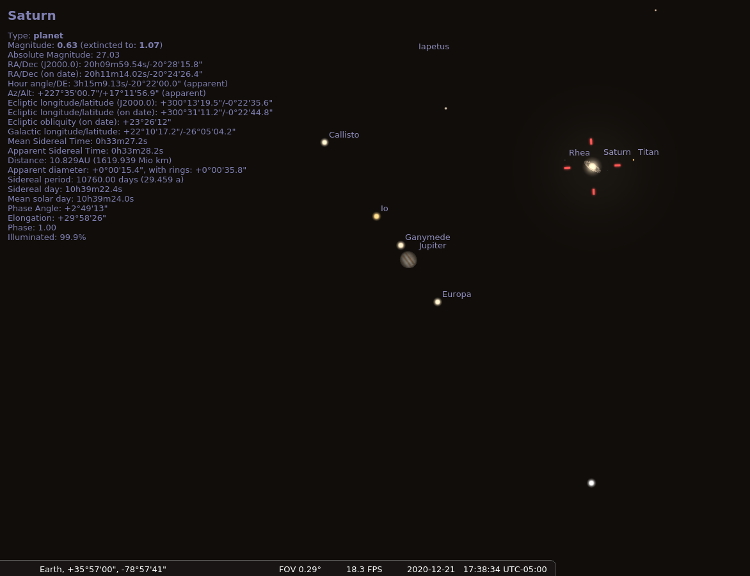
Not only are we going to cross the line on December 21st with the winter solstice, so the days start getting longer thereafter, but we’re going to have an interesting conjunction visible in the early evening sky. Courtesy of Astronomy Picture of the Day (among numerous other sources of course,) we have word that Jupiter and Saturn are going to be unusually close that evening soon after sunset. Much closer, in fact, than their photo, or mine above, shows – much closer than any photo shows, because this is the first time they will be this close since the year 1623. I suppose if you dug around a little you might find a woodcut, but it wouldn’t illustrate much, because they’re going to be that close. Or if you like, let’s go to Stellarium to illustrate it.

If you’ve ever used a pair of binoculars or a long lens to actually see Jupiter’s moons or Saturn’s rings, you’ll know that this image is magnified significantly – by naked eye, it’s likely you’d mistake the two planets for one bright object unless you were paying attention. In astronomical terms, they’ll be 6 arcminutes apart, which translates to about .1 degrees – the moon is roughly 32 arcminutes or .5 degrees in width, for comparison.
Note that both planets set not too long after sunset, so there’s a narrow window to see them – Stellarium is a great resource (I’ve probably said that before) to allow you to know exactly where and when they will be visible for your area. You also have plenty of time to find someone with a telescope, or get one yourself, or (in my case) get it tricked out decently for photography, but at the very least, have a good set of binoculars handy.
The reason that this hasn’t happened since 1623 is simply orbital mechanics. First off, the two planets are quite far out there and have orbits that take them much longer than a year to complete. More or less, anyway, since the definition of ‘year’ really means one orbit of the sun, so they both take exactly a year to complete, but a Jovian year is 11.8 Earth years, while a Saturnian one is 29.4 Earth years. At the same time, their orbits are inclined like ours is, so we not only need a point when both moons are in the same relative direction from us, but their orbits are intersecting at the same rough point. And that would be December 21st.
‘Close’ is relative, of course; as much as they appear right next to each other, they’ll be about 733,226,000 kilometers apart. For reference, at the same time we (Earth, unless you’re one of dem lizard people) will be only 147,157,000 km from the sun. So, you know, we probably don’t have to worry about Jupiter’s and Saturn’s moons colliding or anything. And just for the sake of it, the orbits really will align so close that Jupiter will pass directly in front of Saturn, from our viewpoint here on Earth – in the year 7541. So yeah, mark that on your calendars…
This also takes place slowly, so go ahead and check them out both before and after that date, when they’ll be pretty damn close but not the absolute closest – just in case the weather doesn’t cooperate in your area. Again, Stellarium will help you see what this may be like, as well as helping you locate them in the sky (which really shouldn’t be necessary – they’ll be pretty obvious.)
The photo at top, by the way, is one of mine, from December 1st, 2008 – I ran across it and thought it might serve for an ‘On this Date’ post, but December 1st wasn’t a Wednesday this year. And it doesn’t show Jupiter and Saturn (plus the moon,) but Jupiter and Venus instead – it’s easy to be pretty sure they’re planets because no stars are that bright. I had to drive around a little before I could get all three in the pic, with the tree cover in my area, and you can see that one of them was almost lost in the leaves. They’re not particularly close – as indicated above, on the 21st they’ll be well within the width of the moon (though not actually near the moon.)
So have at it, and good luck!




















































